Hot As Hell

Hell is hot, as everyone knows. Everyone “knows” this, but there really is no conclusive evidence: no eyewitness reports, no scientific instruments to measure the temperature in Hell. So, how do we “know” that Hell is hot? Well, mostly from Dante Alighieri.
In the Inferno, part of his opus magnus, La Commedia Divina (The Divine Comedy, subject of our 3Q 2007 letter, https://angeles-srv.s3.amazonaws.com/content./1441740962./2007-3.pdf,
there are Nine Circles of Hell, each with eternal punishment of increasing severity, depending on one’s earthly behavior. The Sixth Circle is reserved for heretics, condemned to eternal existence in flaming tombs. The Seventh Circle is for those who committed violence, and it contains three categories (rings). The first ring is for murderers, and they are held in a river of boiling blood and fire. The third ring of the Seventh Circle holds blasphemers and sodomites, captive in a desert of burning sand and burning rain falling upon them. These are the exact places in Hell that are hot.
A few centuries later, John Milton gave us this description of Hell, in his masterpiece, Paradise Lost:
A dungeon horrible, on all sides round,
As one great furnace flamed; yet from those flames
No light, but rather darkness visible….
Torture without end
Still urges, and a fiery deluge, fed
With ever-burning Sulphur unconsumed.
So there you have it. We know that Hell is hot because Dante Alighieri and John Milton tell us so. We have no reason to doubt them, and I wouldn’t suggest otherwise, but still, a little more evidence would be welcomed.
In the past few months, the United States was hit with a series of epic natural disasters, including three category 4+ hurricanes (Harvey, Irma and Maria) and devastating wildfires in northern California. Were these just the random occurrences of fickle weather patterns, or part of a changing climate? What is the evidence?
There is no direct evidence that ties a particular weather event with climate change, just as there are no hard data that tell us Hell is hot. But we are able to move beyond the political narratives of climate change proponents and skeptics to a growing body of evidence that (a) the Earth’s climate is warming (i.e., beyond the normal observed variation in temperature), and (b) human activity is the proximate cause of this warming. The consequences of this warming are significant, and probably understated, and our options for action are likely pretty limited. So, in order, let’s examine the evidence, the causes, the consequences, and the possible responses.
The Evidence
Let’s look at average global temperatures for land and oceans since 1880. The first graph shows average temperature by year relative to the average temperature from 1901-1960. The blue bars, mostly before 1901, show temperatures a fraction of a degree Fahrenheit below the long-term average, and the red bars show average temperatures above the long-term average. For the last thirty years, the global annual average temperature is 1.20 F (0.70 C) above the long-term average.
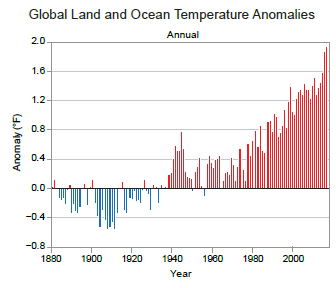
Source: Climate Science Special Report, Fourth National Climate Assessment, U.S. Global Change Research Program
The next set of graphs look at multiple data sets for land temperature, sea temperature and sea level, beginning in 1860-1880. All data sets show a similar pattern of rising temperatures on land and in the sea, as well as a rise in sea levels.
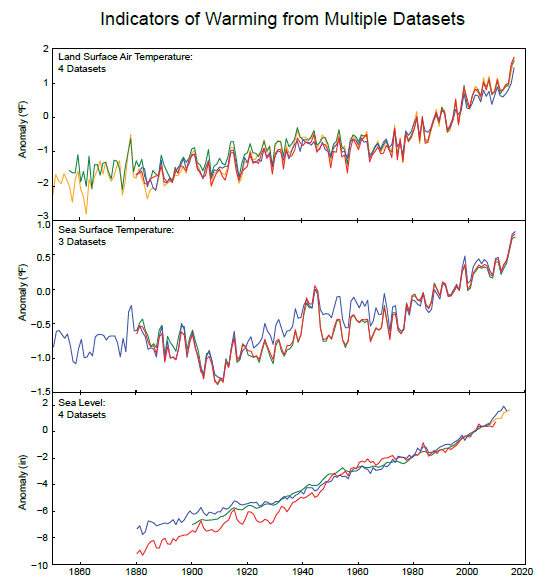
Source: Climate Science Special Report, Fourth National Climate Assessment, U.S. Global Change Research Program
So the last 150 years has gotten warmer, but that’s a blink in time. The next graph looks at evidence in the Northern Hemisphere over the past 1,700 years. Temperature records don’t go back that far, but proxy data, such as ice core samples, are available. The shading represents the possible range around the black regression line. However interpreted, the last decade was the warmest in at least 1,700 years.
Changes in Northern Hemisphere Temperature, 300-2015 BCE
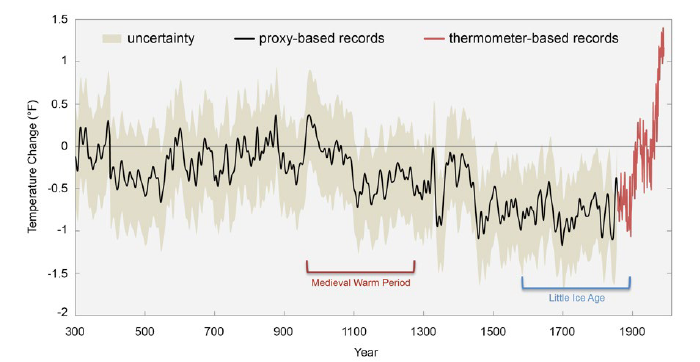
Source: Climate Science Special Report, Fourth National Climate Assessment, U.S. Global Change Research Program
If 1,700 years is not long enough, the IMF has pieced together research from NASA, the Royal Netherlands Meteorological Institute, the Intergovernmental Panel on Climate Change, et. al., to estimate average global temperatures for the past 22,000 years (note the y-axis scale is degrees Celsius). The earth was warming for the first 12,000 years, then cooling for the past 10,000 years, until the past few decades when temperatures have spiked higher.
Average Global Temperatures (Degrees Celsius), 20,000 BCE – Present
 Source: IMF
Source: IMF
Recognizing that some people prefer looking at pictures rather than at data, below are photos of the Muir Glacier in southeast Alaska in 1941 and in 2004. You will see that the glacier has retreated four miles, out of the picture. Also note that the rocky landscape in the foreground has been replaced by dense vegetation.
Muir Glacier, Alaska, 1941 and 2004

Source: Climate Science Special Report, Fourth National Climate Assessment, U.S. Global Change Research Program
Below are photos of the scope of the Arctic sea ice, in 1984 and in 2016, both in the month of September. Arctic sea ice in September covered 3 million square miles in 1980, and it is now less than 1.8 million square miles, shrinking at a rate of 13.3% per year.
Range of Arctic Sea Ice, September, 1984 and 2016

Source: Climate Science Special Report, Fourth National Climate Assessment, U.S. Global Change Research Program
The Causes
Natural factors, such as changes in energy from the sun or the cooling effects of volcanic eruptions, played a large role in the earth’s climate over billions of years, even millions of years. But recently, natural causes of warming have had immaterial effect on the earth’s climate. Instead, it is clear that human activity has altered the earth’s radiative balance. These factors are called radiative forcings, and they include greenhouse gases and airborne particles, et.al. We can see this in the atmospheric concentration of these radiative forcings, which have fluctuated regularly and normally over the past 800,000 years, as the graphs below show, but have spiked well beyond any level seen in this period (for those who don’t remember their high school chemistry, CO2 is carbon dioxide, CH4 is methane and N2O is nitrous oxide).
Atmospheric Concentration of CO2, CH4, N2O in Past 800,000 Years
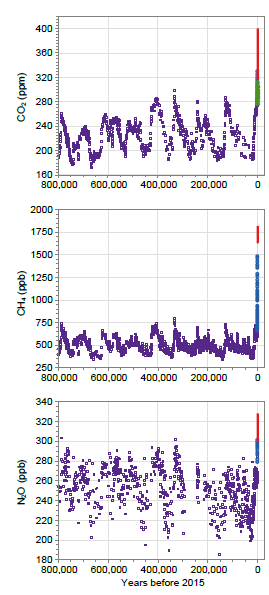
Source: Climate Science Special Report, Fourth National Climate Assessment, U.S. Global Change Research Program
When we collate the data for land and sea temperatures, and consider all the potential causes for the accelerating increases in temperatures, not only do the data all point to human activity as the proximate cause of global warming, there is no alternative explanation that stands up to the evidence. The graph below shows the increase in land and sea temperatures from their average since 1880 (black line) with the sources of that increase. The yellow line shows natural causes, such as solar output, volcanic activity and orbital changes. These have had very little impact. Greenhouse gases (GHG—blue line) and human factors (red line), which include GHG, ozone and aerosol emissions and land use (such as deforestation), account for all of the temperature rise.
Increase in Average Global Temperature and Contributions of Key Factors,
(Deviation from 1880-1910 average, degrees Celsius)
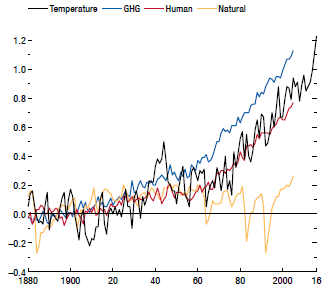 Source: IMF
Source: IMF
Our oceans, covering about 70% of the earth, are taking the brunt of the damage from rising temperatures. Since the mid-20th century, 93% of the excess heat caused by greenhouse gases have been absorbed by the oceans, making them warmer and more acidic. The acidity is caused primarily by CO2, and more than a quarter of the CO2 emitted annually settles in the oceans. Acidity damages marine ecosystems, from coral reefs on up the food chain.
The warming is also causing sea levels to rise. Since 1900, sea levels have risen 7-8 inches, with 3 of those inches occurring just since 1993. The first graph below shows the change in sea level over the past 2,500 years. The graph below shows the change since 1800, along with a range of model projections. Please note the scale of the y-axis of the second graph is approximately ten times the magnitude of the first. There is a massive rise in sea levels going on.
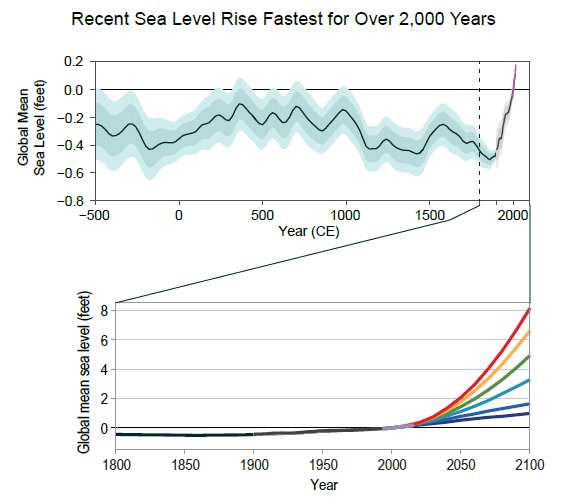
Source: Climate Science Special Report, Fourth National Climate Assessment, U.S. Global Change Research Program
There is a clear negative correlation between temperature and economic output. The graph below shows the impact of a 10 C change in temperature on GDP at various temperature levels, with the red vertical lines representing the average temperature for each country grouping. Advanced economies are found mostly in temperate climates, whereas emerging and low-income countries are found in warmer places. The negative impact of warmer temperatures is thus magnified for poorer countries.
Effect of Temperature Increase on Real per Capita Output
![]()
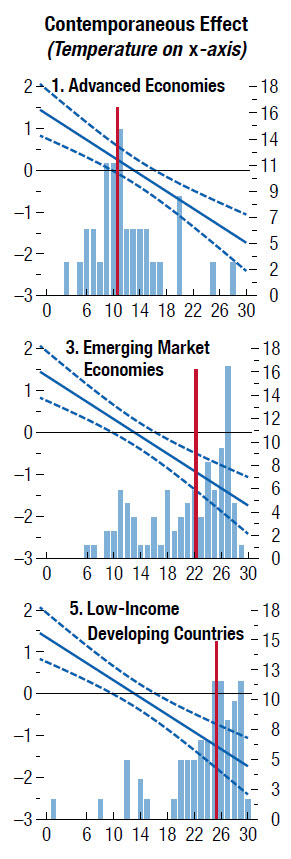 Source: IMF
Source: IMF
The impact of global warming on economic output thus varies. As can be seen in the first map below, Canada and Russia are probably helped, the US, Europe and China see modest impact, and the rest of the world sees a material decline in GDP for a 10 C temperature rise. Unfortunately, most of the world’s population lives in the red zone. The second map is scaled by population.
Effect of 10 C Temperature Rise on Real per Capita Output across the Globe
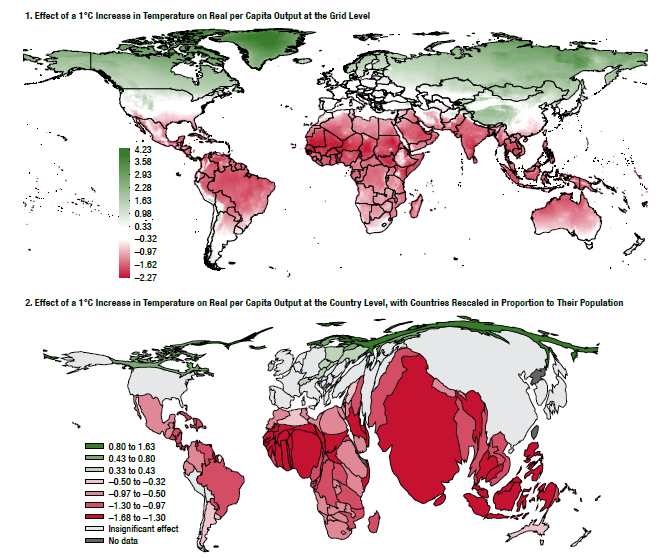 Source: IMF
Source: IMF
The historical data are well-established facts. The projections are models, and all models are flawed. They are flawed in that they do not account, or fully account, for all the processes of the Earth’s systems (e.g., ice sheets or arctic carbon reservoirs), or all the interactions among these components. The models do not, of course, account for unknown processes, although our models have underestimated the actual temperature changes during warming paleoclimates, which suggests that unknown processes not represented in the current models are more likely to underestimate than overstate the impact of warming.
There are two types of potential surprises in the modeling, and neither one of them is good. The first is the correlation between extreme events that could result in compounding extreme events, i.e., one extreme event follows immediately on another, and so on. These may be simultaneous droughts that occur in multiple places around the globe, or droughts lasting decades, or droughts followed by flooding, for example.
The second potential surprise in the modeling are tipping points, i.e., components of the Earth’s system that are stable until they are not, when small changes are amplified by a positive feedback loop. Patterns of ocean circulation may be such an example. Most of us in California are familiar with El Niño, which is actually part of the El Niño—Southern Oscillation (ENSO). Warming temperatures are likely to trigger more frequent and stronger ENSO patterns. Another important ocean circulation is found in the Atlantic Meridional Overturning Circulation (AMOC), where cold water sinks off of Greenland. Global warming would likely slow this pattern, leading to sea rise on the eastern US seaboard. A third potential tipping point may be found in the Arctic. Warming temperatures threaten to release carbon and methane hydrates currently frozen in the permafrost, which may lead to a positive feedback loop of faster warming. There is an estimated 1,300-1,600 Gt (gigatons) of carbon, and 2,400 Gt of methane trapped in the permafrost.
What Can We Do
On one level, probably nothing, because climate dynamics play out over long periods of time. For example, a quarter of the CO2 emitted today will still be in the atmosphere 1,000 years from now. Just as the effects of global warming will be felt for a very long time, any changes we make today will have only marginal impact over the short scale of a human lifetime. Still, as Lao Tzu observed, a journey of 1,000 li begins with a single step (in Lao Tzu’s time, one li was about 360 miles). What are those first steps?
One first step is to accept individual responsibility for global warming and change our behavior. We can put solar panels on our homes, drive electric cars, walk or bike instead of driving. There are many actions we can take as individuals, and many websites with good suggestions (here’s one: https://www.nrdc.org/stories/how-you-can-stop-global-warming).
As citizens, we can urge our representatives at all levels of government to take this challenge seriously, to take direct measures to reduce government’s carbon footprint, and also ensure that the true cost of emissions is reflected in its price. Global warming is a negative externality, in economic-speak, of “potentially catastrophic proportions,” in the words of the IMF’s recent report, and government has an obligation to ensure that its costs are made explicit.
As investors, the challenge of climate change is more complex. We are free, of course, to invest our personal money in a way that reflects our personal values, but as fiduciaries of institutional assets, we have as a primary obligation the financial health of our organizations. It’s not quite so simple and straightforward to balance this fiduciary obligation with the need to combat climate change. There is a positive approach to this, and a negative one, and both have their challenges.
The positive approach is to invest in companies or projects that actively combat global warming, such as renewable power, for example. There may be specific, attractive opportunities in private equity for these projects, but returns in public markets have lagged. S&P and TSX have a Renewable Energy and Clean Tech Index. Since its inception in March 2010, it has returned 7% annualized, versus 9% for the MSCI ACWI and 13.3% for the S&P 500.
The negative approach is best characterized by divestment, by shunning investments in companies or projects that contribute to global warming. The premise behind divestment is that it will punish bad actors by raising the cost of capital and thus prodding them to modify their behavior. As a fiduciary, it is also presumed that divestment can be implemented without cost, either direct or opportunity cost, or even hoped that returns will be enhanced by avoiding irresponsible companies. All this would be nice if it were true, but the evidence is just not supportive.
The long divestment campaign against South Africa, for example, had “little discernible effect either on the valuation of banks and corporations with South African operations or on the South African financial markets,” according to a study by Siew Hong Teoh of Michigan, Ivo Welch of UCLA and Paul Wazzan. Harrison Hong of Princeton and Marcin Kacperczyk of University of British Columbia have found that “sin” stocks have had higher returns than the broad markets.
There is simply no evidence that divestment campaigns have modified company behavior, or have had any noticeable impact on their cost of capital, or have been able to be implemented at no cost to investors. There is simply no evidence that avoiding irresponsible stocks does any actual good. And climate change is too important for slogans and symbols; it requires action.
The Ninth Circle
The final Circle of Hell, Dante tells us, is reserved for those who have committed treachery against those with whom they had a special relationship. There are four rings in this Circle. The first is named after Cain, who killed his brother Abel in the book of Genesis. The last ring is named for Judas Iscariot, who betrayed Jesus.
But rather than burning in Hell, those who committed treachery are actually frozen in Hell, for in the Ninth Circle of Hell is found a frozen lake, Cocytus, where the treacherous are held in varying degrees of frozenness. Cain, in the first ring, has his head above the ice, but by the time we get to the fourth ring, Judas is completely encased in the ice.
It’s worth summarizing the key findings of the US government’s recently released Fourth National Climate Assessment:
The global climate continues to change rapidly compared to the pace of the natural variations in climate that have occurred throughout Earth’s history. Trends in globally averaged temperature, sea level rise, upper-ocean heat content, land-based ice melt, arctic sea ice, depth of seasonal permafrost thaw, and other climate variables provide consistent evidence of a warming planet. These observed trends are robust and have been confirmed by multiple independent research groups around the world.
The frequency and intensity of extreme high temperature events are virtually certain to increase. It is extremely likely that human influence has been the dominant cause of the observed warming since the mid-20th century. There are no convincing alternative explanations supported by the extent of the observational evidence.
I don’t know if Dante’s description of Hell is accurate, if heretics and murderers and blasphemers are fated to burn for eternity, and if those who betrayed ones with whom they had a special relationship are condemned forever in a frozen lake. I do know that we need to advocate, agitate and act. Now. We have betrayed our special relationship with Nature, and for that treachery, I think Dante was right: we will be condemned to the Ninth Circle of Hell.

